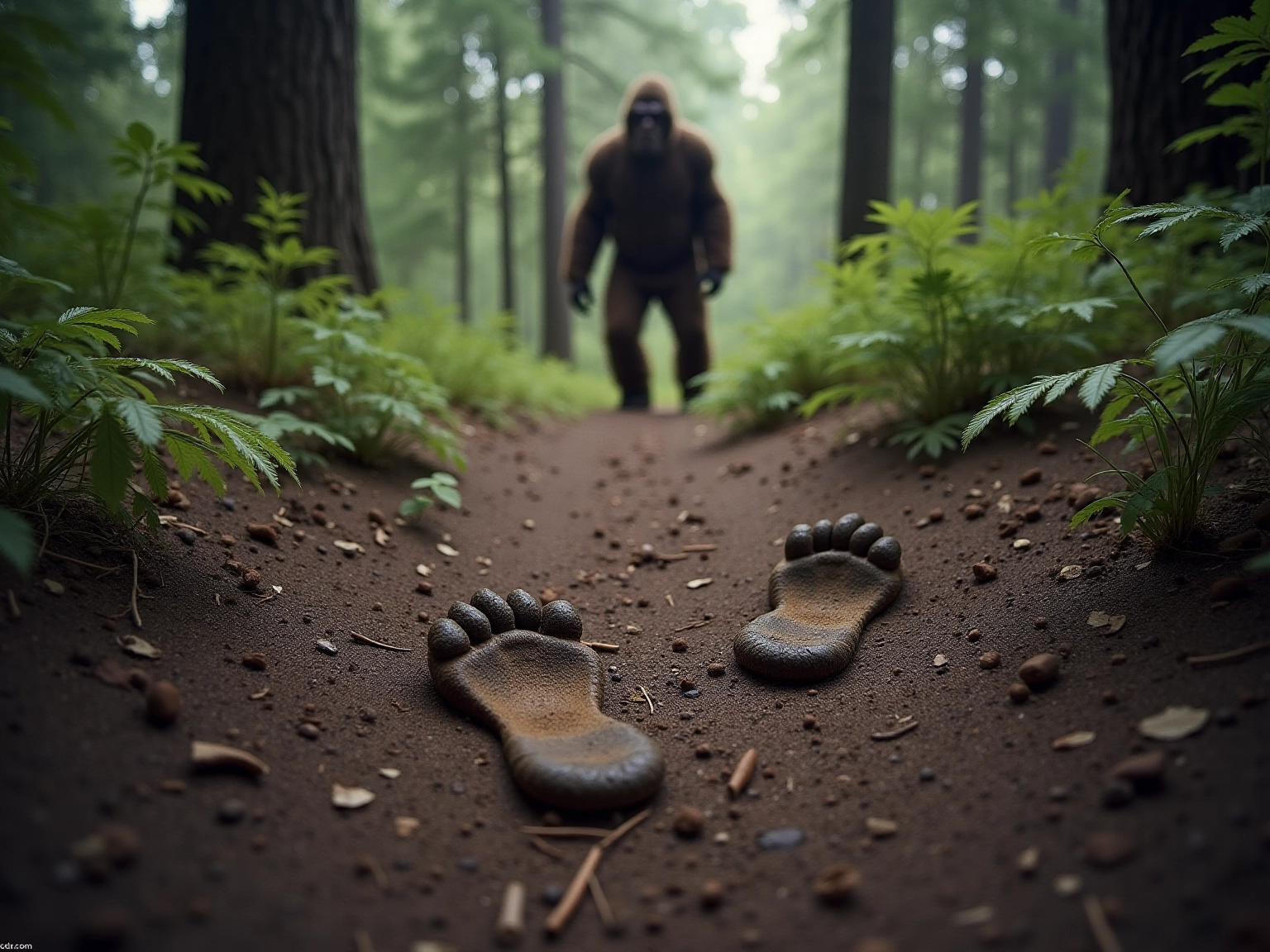Overview
Have you ever heard of Bigfoot? In Ohio, this legendary creature goes by the name Grassman, and it has quite a fascinating story! The article dives into the intriguing world of Grassman, showcasing a whopping 318 reported encounters throughout the state. Can you imagine the excitement of those who’ve spotted it?
What really adds to the allure are the various forms of evidence, like footprints and audio recordings, that fans of this folklore have gathered. Eyewitness accounts play a crucial role, too! They not only spark curiosity but also encourage community engagement in the ongoing research and exploration of this captivating creature. So, if you’re intrigued, why not delve deeper into the mystery of the Grassman? There’s a whole world of stories waiting for you!
Key Highlights:
- Bigfoot, known as the Grassman in Ohio, is revered in local folklore as a guardian of the forest.
- The Grassman is described as a 6 to 10 feet tall, hairy figure, often associated with a strong, musky odor.
- There is a 3.5% chance of spotting Bigfoot in Ohio, with statistical odds of +2750.
- The Hocking Hills Festival celebrates the Grassman, showcasing its cultural impact and attracting thousands.
- Ohio has recorded 318 Bigfoot sightings across all 88 counties, with notable encounters reported in Cuyahoga Valley National Park.
- Evidence for Bigfoot includes large footprints, audio recordings of howls, and eyewitness accounts, which provide context for sightings.
- Eyewitness reports are vital for understanding encounters, with descriptions adding depth to the narrative.
- Aspiring Bigfoot researchers are encouraged to prepare by exploring known sighting areas and using quality equipment for documentation.
- Safety is paramount during investigations; researchers should stay aware of their surroundings and maintain distance from wildlife.
Introduction
In the heart of Ohio, a legendary figure stirs the imaginations of locals and visitors alike—Bigfoot, or as many in the region call it, the Grassman! This towering, elusive creature is steeped in rich folklore and is often regarded as a guardian of the forest in Native American traditions.
With a remarkable history of sightings and a vibrant community dedicated to its lore, Ohio has become a hotspot for Bigfoot enthusiasts. From annual festivals celebrating the myth to a staggering number of reported encounters across its counties, the Grassman continues to weave itself into the cultural fabric of the state.
As you delve into the evidence surrounding this enigmatic being, you’ll uncover not just tales of mystery but also a deeper connection to Ohio’s natural landscapes and the stories they inspire. Isn’t it fascinating how folklore can connect us to the places we explore?
Explore the Mythology of Bigfoot in Ohio
Sasquatch, often seen as a mythical being, truly captivates the imagination of many, especially in the region where its mythology is woven into local folklore. In Native American traditions, this legendary creature is revered as a guardian of the forest, embodying the spirit of nature and protecting wildlife. In Ohio, folks often refer to bigfoot in Ohio as the Grassman, a name that highlights the unique adaptations of the Sasquatch myth in this area.
Picture this: the Grassman is typically described as a towering, hairy figure, standing anywhere from 6 to 10 feet tall, often accompanied by a strong, musky odor. This vivid imagery isn’t just a product of folklore; it shapes how sightings are reported and understood by both enthusiasts and skeptics. Statistically, there is a 3.5% chance of spotting bigfoot in Ohio, with odds of +2750, adding a fascinating quantitative twist to the phenomenon’s presence.
The cultural significance of bigfoot in Ohio shines through events like the Hocking Hills Festival, which celebrates the myth and attracts thousands of attendees. The first festival welcomed over 10,000 people, showcasing its positive impact on local tourism and community spirit. Bea Mills, the festival organizer, shared, “So, keeping it fun and light-hearted is just paramount. And it’s actually absolutely fantastic to watch.”
Moreover, the Grassman legend intertwines with various cultural narratives, emphasizing its role in local festivals and community events. This ensures that the myth remains vibrant and relevant in today’s society. As the Grassman, often referred to as bigfoot in Ohio, continues to spark curiosity and exploration, it serves as a delightful reminder of the rich tapestry of folklore that shapes Ohio’s identity and cultural heritage.
Chronicle of Bigfoot Sightings in Ohio
Ohio is a fantastic spot for enthusiasts of bigfoot in Ohio, with stories coming from all 88 counties and a whopping 318 reported encounters! One of the most fascinating sightings took place in Cuyahoga Valley National Park, where witnesses described a towering 9-foot creature emerging from the water at incredible speed. In 2024, a hunter in Richland County even reported an encounter with a Sasquatch while building a deer stand—how cool is that? This adds to the growing list of experiences that keep us all intrigued.
The Field Researchers Organization (BFRO) has put together a comprehensive database that records these encounters, complete with eyewitness accounts and geographical insights. This repository not only highlights how common these sightings are but also reveals some intriguing patterns about where they occur—mostly in dense forests and rural areas. With technology continuously advancing, we now have new tools for gathering evidence, making the search for this elusive creature more accessible and exciting for fans like you!
As the BFRO puts it, “These platforms allow enthusiasts to connect, share experiences, and contribute to the collective understanding of the species.” Isn’t that wonderful? Recognizing these patterns and the community aspect of Sasquatch research is essential for anyone eager to dive into their own investigations.
Moreover, insights from the case study titled “Exploring Cryptid Habitats and Ecosystems: Where Legends Lurk” suggest that the environments where cryptids are spotted can shape the stories surrounding them, adding depth to the field of cryptozoology. This connection to Ohio’s natural landscapes not only enriches the search for the mythical creature but also ties into the creative and cultural narratives that The Design Tourist loves to highlight. So, are you ready to delve into the mysteries surrounding Bigfoot in Ohio?
Examine Evidence: Footprints, Sounds, and Eyewitness Accounts
Evidence supporting the presence of the creature in the state mainly comes from large footprints, audio recordings of howls, and eyewitness accounts. Did you know that footprints linked to the mythical creature can reach lengths of up to 17 inches? Stride lengths suggest a large, bipedal being! The Ohio Howl—a unique vocalization documented in the state—has puzzled specialists and is often associated with encounters of Bigfoot in Ohio. Eyewitness accounts, while anecdotal, provide crucial context that helps researchers understand the circumstances surrounding these encounters. For instance, an unnamed man recounted his experience, saying, “Look at it, it’s not a person, you can see all the hair. His hair is grey and black.” This vivid description adds depth to the narrative of eyewitness experiences.
When evaluating evidence, it’s essential to assess the credibility of the source and the conditions under which the evidence was gathered. A fascinating case study involves a family camping at Pleasant Hill Lake Park in August 2020. They reported hearing objects thrown at their campsite and then witnessing a tall, dark, hairy figure retreating into the woods. This incident highlights the importance of collecting credible sightings while debunking false claims. Notably, Ferencak, a member of the Field Researchers Organization, has been documenting potential Sasquatch encounters for nine years, which adds credibility to the ongoing investigations.
If you’re eager to document and analyze potential Bigfoot evidence, here are some handy tips:
- Use high-quality audio recording devices to capture sounds that may be attributed to Bigfoot, like howls or knocks.
- Take clear photographs of any footprints, making sure to include a scale reference for size comparison.
- Keep comprehensive records of the time, location, and environmental conditions during observations or evidence gathering.
Moreover, the department encourages those intrigued by Sasquatch research to dive deeper and become part of their group, fostering a community of enthusiasts committed to uncovering the truth behind these sightings.
By following these guidelines, you can contribute valuable information to the ongoing study of Bigfoot in Ohio. This not only enhances your understanding of this mysterious being but also allows you to partake in a unique adventure that connects you with the secrets of the natural world!

Conduct Your Own Investigation: Tips for Aspiring Bigfoot Researchers
If you’re eager to dive into your own Sasquatch investigations, thorough preparation is key! Start by exploring areas with a history of sightings, like Salt Fork State Park, known for its frequent encounters. It’s worth noting that in the summer of 2016, a second black bear was confirmed in Indiana, which highlights the chance of misidentifying cryptid sightings.
Make sure to equip yourself with essential tools. A high-quality camera is a must for capturing evidence, audio recording devices are great for documenting sounds, and a trusty notebook will help you log your observations and experiences.
While you’re out in the field, prioritize your safety! Keep a respectful distance from wildlife and stay alert to your surroundings. As Floe Foxon wisely said, “If bigfoot is there, it may be a bear,” reminding us to differentiate between various wildlife during our investigations. Engaging with local cryptid research groups or attending relevant conferences can also be incredibly beneficial. These gatherings allow you to connect with fellow enthusiasts, share insights, and learn from others’ experiences.
Carefully recording your observations not only enriches the collective knowledge about this elusive creature but could also lead to significant discoveries. To help you on your journey, here’s a handy checklist of essential equipment and safety tips:
-
Equipment Checklist:
- High-quality camera
- Audio recording devices
- Notebook and pen
- Flashlight
- Binoculars
- GPS device
-
Safety Tips:
- Stay aware of your surroundings
- Maintain a safe distance from wildlife
- Inform someone of your location and expected return time
-
Resources for Further Learning:
- Local Bigfoot research groups
- Online forums and communities
- Books and documentaries on Bigfoot investigations
Additionally, habitat suitability models suggest that Indiana could support more black bears in the future, which may change the dynamics of wildlife encounters in the area. By following these guidelines and considering the ecological context, you can enhance your investigative efforts and contribute meaningfully to the ongoing exploration of Bigfoot sightings!
Conclusion
The Grassman, Ohio’s own version of Bigfoot, is a captivating figure woven into local folklore. It embodies the spirit of nature and acts as a guardian of the forests. Celebrated at events like the Hocking Hills Bigfoot Festival, this legend brings the community together and boosts local tourism, making it a vital part of Ohio’s cultural landscape. With over 300 reported sightings across the state, the Grassman continues to intrigue both enthusiasts and skeptics alike, inviting us to delve into its mysteries.
Evidence supporting Bigfoot’s existence includes:
- large footprints
- unique sounds
- compelling eyewitness accounts
While these are often anecdotal, they significantly enrich the narrative surrounding this elusive creature. Plus, with technological advancements, researchers are better equipped to document their findings, underscoring the importance of credible investigations.
If you’re interested in embarking on your own Bigfoot research, being well-prepared with the right tools is essential! Connecting with local research groups and attending related events can truly enhance your experience and foster a sense of community among fellow enthusiasts.
Ultimately, the Grassman symbolizes the enchanting allure of folklore, linking people to Ohio’s stunning natural landscapes and sparking curiosity about the legends that shape our understanding of nature. Whether you approach this with skepticism or belief, the quest for the truth behind the Grassman continues to invite exploration and wonder!
Frequently Asked Questions
What is Sasquatch often referred to in Ohio?
In Ohio, Sasquatch is commonly referred to as the Grassman.
How is the Grassman described in terms of appearance?
The Grassman is typically described as a towering, hairy figure, standing anywhere from 6 to 10 feet tall, often accompanied by a strong, musky odor.
What is the statistical chance of spotting Bigfoot in Ohio?
There is a 3.5% chance of spotting Bigfoot in Ohio, with odds of +2750.
What cultural event celebrates the myth of Bigfoot in Ohio?
The Hocking Hills Festival celebrates the myth of Bigfoot, attracting thousands of attendees.
How many people attended the first Hocking Hills Festival?
The first Hocking Hills Festival welcomed over 10,000 people.
What is the significance of the Grassman legend in Ohio?
The Grassman legend plays a significant role in local festivals and community events, ensuring that the myth remains vibrant and relevant in today’s society.
How does the Grassman embody local cultural heritage?
The Grassman serves as a reminder of the rich tapestry of folklore that shapes Ohio’s identity and cultural heritage, highlighting its importance in local traditions and community spirit.


































